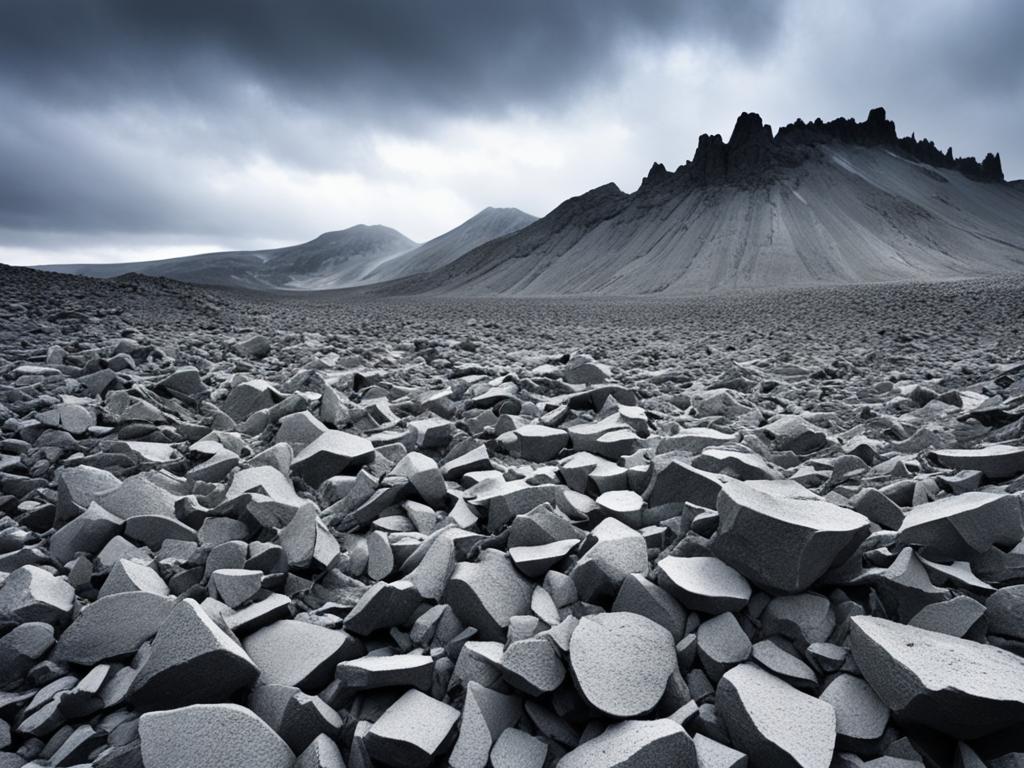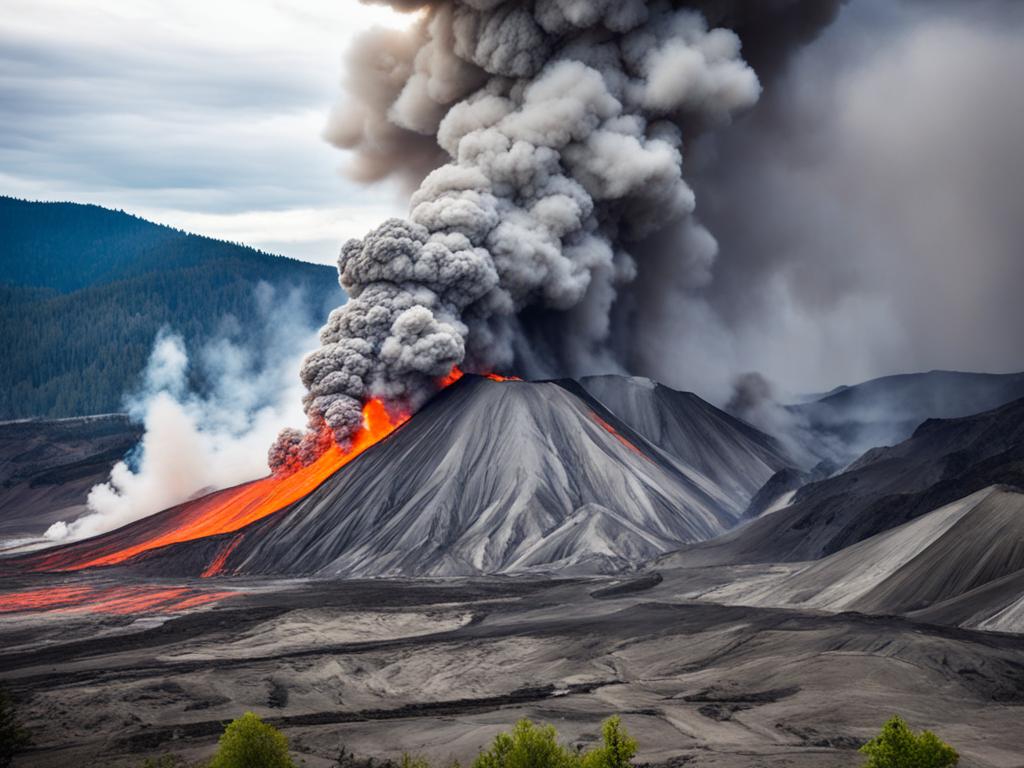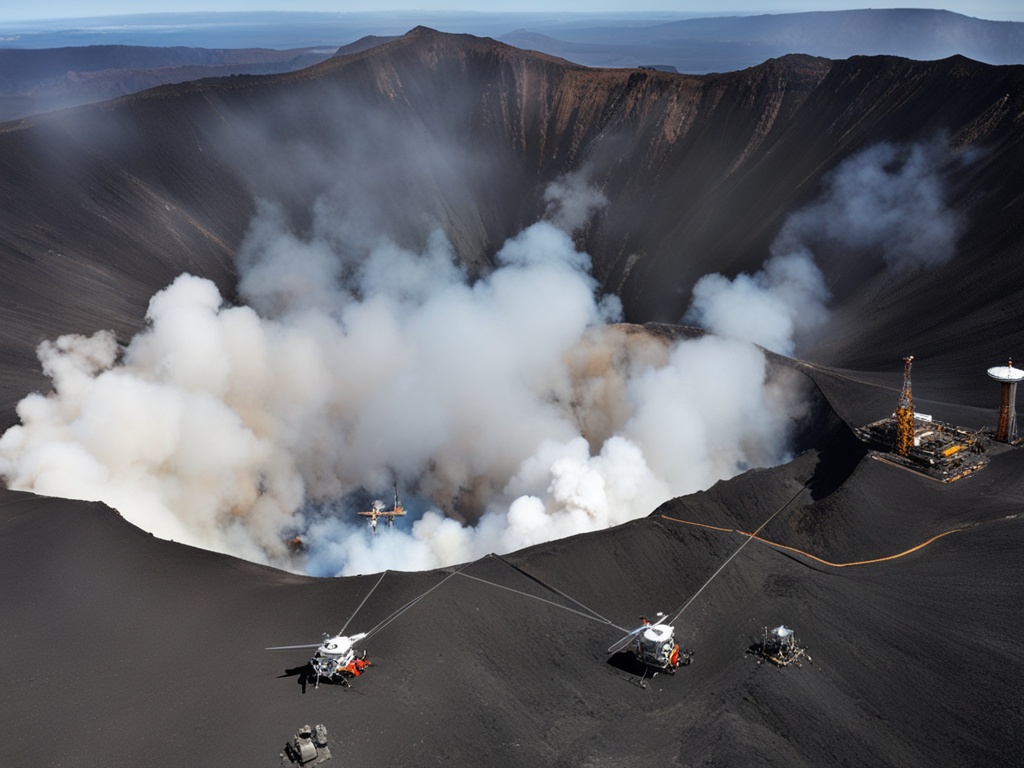Volcanoes shape our world by making land where life can grow. They build mountains and carve out deep pits. Lava flows turn dull areas into new land. These volcanic lands become rich soil over time, helping plants and people to live. There are many active volcanoes worldwide, with 161 in the United States alone. These volcanoes have different ways of erupting, from slow flows to sudden blasts, based on the lava’s thickness. Thick lava causes big explosions, while thin lava flows more calmly down the slopes.
Key Takeaways
- Over 80% of the Earth’s surface has been created by volcanoes.
- There are approximately 1,500 potentially active volcanoes around the world, with over 10% located in the United States.
- Volcanoes can exhibit both explosive and effusive eruptions, depending on the viscosity of the magma.
- Effusive eruptions are more common when the magma is less viscous, allowing gas to escape and the magma to flow down the volcano’s slopes.
- Explosive eruptions occur when viscous molten rock traps gases, building pressure until it violently breaks free.
What Are Volcanic Hazards?
A volcanic hazard is any risky volcanic activity that can harm people or their homes. This includes dangers like lava flows, pyroclastic flows, lahars, and tephra. It can endanger lives near and far from the volcano, impacting big areas by destroying landscapes.
Lava Flows and Their Impact
Lava flows move quite slowly, letting people usually escape safely. They destroy by burying or burning everything in their path. Types of lava have different risks. Some like basalt are very fluid and can flow fast, while others like andesite move slower and may give more time to get away.
Pyroclastic Flows: A Deadly Force
Pyroclastic flows are swift and burning, covering the ground in deathly hot clouds. They move as fast as a speeding truck, endangering anyone in their route. The 1902 eruption of Montagne Pelee is a tragic example of their power, where about 30,000 people lost their lives.
Volcanic Gases and Their Effects
Volcanic gases can be dangerous for health and the atmosphere. When they mix with air, they can create deadly pollution. Ash from eruptions can cause roofs to collapse and disrupt transportation. It can damage engines in planes, boats, and cars, affecting how people and goods move around.
Volcanic Products and Tephra
Volcanic products are named by their size, with “tephra” as the general term. “Ash” includes particles under 2 mm. Most tephra falls near the volcano. It can layer roofs, hide road signs, and hurt farming by covering plants or breaking branches. Ash, because it’s fine, can travel with the wind for thousands of kilometers, even to the stratosphere. This ability poses serious threats to aircraft, damaging their engines and parts with its rough texture.
Ashfall and Its Consequences
When volcanic ash falls, or ashfall happens, areas face several problems. The ash’s weight can make roofs cave in, wreck buildings, and stop roads. It also jams machines, poisons water, and makes breathing hard. Plants covered by ash can die, which is very bad for farms and could cause a lack of food and money for people. If the ash spreads far, it can also be very dangerous for planes. It might scratch up or ruin an aircraft’s vital parts or engines, leading to very bad accidents.

Volcanism: Understanding Volcanoes and Their Effects
This part digs deeper into the science of volcanism. It explains how volcanoes form and change the Earth. Volcanoes appear in two main ways. The first is near subduction zones, where tectonic plates collide. The second way is from hotspots, like the one under Hawaii, where magma comes up from deep within the Earth’s crust.
Most volcanoes are found in a zone circling the Pacific Ocean. It’s called the “Ring of Fire.” Out of all active volcanoes, about 75% are in this area. When volcanoes erupt, they affect our climate. They can release gases and particles that cool or warm the Earth.
| Statistic | Value |
|---|---|
| Percentage of Earth’s surface created by volcanoes | Over 80 percent |
| Number of potentially active volcanoes globally | Around 1,500 |
| Percentage of active volcanoes located in the United States | Over 10 percent |
| Percentage of world’s active volcanoes situated around the Ring of Fire | Approximately 75 percent |
| Deadliest eruption in recorded history (Mount Tambora, 1815) | Around 10,000 people killed |
| Estimated number of daily volcanic eruptions | At least a dozen |
Around 80% of the world’s known volcanoes form on plate boundaries. Here, one plate moves over another, which helps create island arcs. Along places where plates separate in the oceans, we find a type of magma called basalt. It forms new ocean floor.
In some spots, like under Hawaii, unusually hot areas in the Earth’s mantle burst through the crust. This action creates chains of islands, with the youngest at one end. In Africa’s Rift Valley, volcanoes also form within a plate. This may be due to that area’s plates slowly pulling apart.
Volcanic Eruptions: Mechanisms and Types
When molten lava reaches Earth’s surface, volcanic eruptions happen. The resulting igneous rock is either extrusive (cooled on the surface) or intrusive (cooled underground). The type of eruption, whether effusive or explosive, depends on the lava’s thickness.
Effusive vs. Explosive Eruptions
Effusive eruptions have fluid lava that flows easily. This allows gas to escape and the lava to move slowly down the volcano. These eruptions are not very violent and give people time to get away.
On the other hand, explosive eruptions happen with thick lava that traps gases. This causes pressure to build until it explodes out. The explosion sends ash, rocks, and gas high into the air, which can be dangerous for nearby areas.
Flood Basalts: Rare but Impactful
Flood basalts are a rare but powerful type of lava flow. They cover huge areas, even continents, with lava as thick as a kilometer. These events release a lot of gas, which can pollute the air and change the global climate. They can also completely cover whole regions with lava, changing the landscape.

| Eruption Type | Lava Viscosity | Gas Escape | Eruption Characteristics |
|---|---|---|---|
| Effusive | Relatively Fluid | Easy | Slower-moving lava flows, allowing time for evacuation |
| Explosive | Viscous | Trapped | Sudden release of pressure, propelling ash, rock, and gases high into the atmosphere |
| Flood Basalt | Highly Fluid | Moderate | Covers large areas, can influence global climate through gas emissions |
Volcanic Landforms and Structures
Volcanoes are mighty forces shaping our Earth’s surface. They create a wide range of unique landforms and structures. One such feature is the lava dome, made by slow, thick lava flows from a volcano. This thick lava can’t move far, so it builds a dome over time.
Lava Domes and Their Instability
Lava domes, though stunning, can be very dangerous. They are often unstable and can suddenly collapse. This can trigger fast-moving pyroclastic density currents. These are powerful avalanches of gas, ash, and rock up to 450 mph.
The speed at which lava flows move depends on factors like lava type. High-silica lavas move slowly, only a few meters per hour. But, more fluid basalts can move several kilometers per hour.
Volcanoes are always changing the Earth’s surface. They leave behind a variety of volcanic landforms and structures. These features, from lava domes to shield volcanoes, teach us about our planet’s complex geology.
Monitoring and Predicting Volcanic Activity
Volcanoes give hints if they might erupt soon. It’s crucial for scientists to watch them, especially near people. Signs like earthquakes, bulging sides, and more gas show the volcano’s activity. But, knowing the exact time of an eruption is impossible. Volcanoes don’t follow a schedule. Plus, they can’t be “late” for an eruption.
Warning Signs of Impending Eruptions
To predict volcanic activity, experts monitor and analyze warning signals. A lot of small earthquakes can mean magma is moving. But, if these quakes stop suddenly, it might show the magma is stuck. This could lead to an eruption. Seeing a big bulge on a volcano’s side might also mean magma is close to the surface.
Gases like H2O, CO2, and SO2 coming out of a volcano’s vents are important signs. Experts watch these volcanic gases closely. This helps spot changes in the volcano’s activity. Instruments like seismometers and tiltmeters are key. They pick up on vibrations and ground movement. This gives crucial info on the volcano’s state.
Today, predicting when a volcano will erupt is getting better. Thanks to new technology and more knowledge of volcanoes, we can do better. By combining data from many sources, ground checks, and aerial views, we can understand volcanoes more. This improves our ability to warn people. It reduces the danger from surprise eruptions.

Volcanic Hazard Mitigation and Preparedness
Living near active volcanoes means facing great risks. So, it’s vital for these communities to prepare well. They need strong plans for both volcanic hazard mitigation and volcanic preparedness. This involves keeping an eye on the volcano, readying for evacuations, strengthening buildings, and teaching people what to do.
Good communication, coordination, and collaboration are keys to safety. Scientists, officials, and the public must work well together. They use different methods to watch the volcano, like looking at its movements or smelling gases. This helps warn people early if an eruption might happen.
The Volcanic Hazards Program (VHP) by the United States Geological Survey (USGS) is very important. They look at both short-term and long-term volcano risks. They study the area, make maps showing danger zones, and work with others to prepare. VHP warns people about local risks and plans before a volcanic eruption.
In 2013, at Pagan Volcano in the Northern Mariana Islands, experts set up special equipment. This gear helps watch over volcanic activity more closely. They’ve found that California has faced ten volcanic eruptions in the last 1,000 years. That’s more than you might think, showing how serious the risk can be.
| Volcanic Hazard Mitigation Strategies | Description |
|---|---|
| Monitoring and Early Warning Systems | Real-time monitoring using different methods to spot eruptions quickly |
| Emergency Evacuation Procedures | Making and practicing plans to leave quickly if a volcano starts to erupt |
| Infrastructure Reinforcement | Building stronger against volcanic threats like ash or lava |
| Public Education Campaigns | Telling people about local volcano risks and getting them ready to act fast |
In a nutshell, it’s crucial for communities near volcanoes to be ready. By following detailed plans for safety, they can lower the danger from eruptions. This not only saves lives but also protects what people have worked hard for from disaster management situations.
Historical Volcanic Eruptions and Their Impact
Volcanic eruptions have changed our history in big ways, causing massive destruction. For example, the 1815 eruption of Mount Tambora in Indonesia was the deadliest known. It killed about 10,000 people instantly, and another 82,000 died later from hunger and sickness.
The Deadliest Eruption: Mount Tambora
The Mount Tambora eruption left a huge caldera, or crater, 4 miles wide and over 3,600 feet deep. It spewed ash and gas into the air, causing a global chill and the “year without a summer” in 1816. This ruined crops, leading to major food shortages that inspired works like Frankenstein.
The Year Without Summer
Some think volcanoes are erupting more now, but it’s not true. What has changed is how we watch and talk about these events. We now know how much volcanoes can hurt us and the planet, pushing us to study and get ready for future outbursts.
Volcanoes and Climate Change
Volcanoes can change the Earth’s climate in many ways. They might make the world hotter or cooler over time. This happens by either releasing or blocking certain gases in the atmosphere.
On a long-term basis, volcanoes can slowly make the Earth warmer. They do this by releasing gases like carbon dioxide into the air. But, this process is very slow, taking millions of years, and isn’t what’s making the Earth heat up quickly now.
Yet, when volcanoes erupt, they can actually cool down the Earth. This is because they send lots of ash and gases high into the atmosphere. These things block some of the sun’s heat, causing temperatures to drop. The big blast of Mount Tambora in 1815 made a “year without a summer.” This showed the quick, but brief, cooling effects of volcanoes.
So, while volcanoes do play a part in the climate, they are not the main reason the Earth is warming now. Humans, by burning fossil fuels, have made a much bigger impact. The gases we produce are 135 times more than what volcanoes release every year. This shows how much more human actions affect our climate.
Source Links
- https://www.nationalgeographic.com/environment/article/volcanoes
- https://www.britannica.com/science/volcanism
- https://www2.tulane.edu/~sanelson/eens1110/volcanoes.htm
- https://www.bgs.ac.uk/discovering-geology/earth-hazards/volcanoes/volcanic-hazards/
- https://uwiseismic.com/volcanoes/hazards/
- https://www.usgs.gov/programs/VHP/about-volcanoes
- https://www.usgs.gov/faqs/how-do-volcanoes-erupt
- https://www.bgs.ac.uk/discovering-geology/earth-hazards/volcanoes/how-volcanoes-form/
- https://www2.tulane.edu/~sanelson/Natural_Disasters/volclandforms.htm
- https://volcano.si.edu/faq/index.cfm?question=eruptionforecast
- https://openoregon.pressbooks.pub/earthscience/chapter/8-7-monitoring-volcanoes-and-predicting-eruptions/
- https://www.usgs.gov/faqs/why-it-important-monitor-volcanoes
- https://www.usgs.gov/programs/VHP/what-we-do-volcano-hazards-program
- https://www.nps.gov/subjects/volcanoes/volcanic-eruptions.htm
- https://www.ncbi.nlm.nih.gov/pmc/articles/PMC3644290/
- https://www.usgs.gov/programs/VHP/volcanoes-can-affect-climate
- https://scied.ucar.edu/learning-zone/how-climate-works/how-volcanoes-influence-climate


